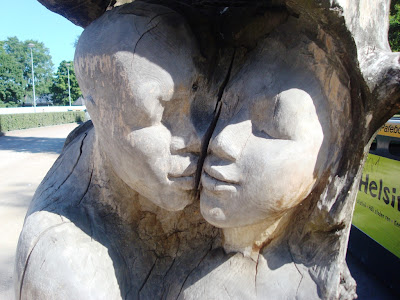
One of my workshops is proving particularly popular wherever I present it. It's a workshop about how to promote creativity in learning, and as you might imagine, I get the audience involved in lots of activities, exercises and games and give them some fun challenges and problems to solve. We also enjoy a lot of dialogue around questions that evolve during the workshop. I challenge teachers to tell me how they recognise when their learners are being creative. It's a difficult task, because most of the time we can't even agree what creativity is. Is music I don't like creative? What about graffiti on a wall? Or a new building design that I think is hideous? Creativity means different things to different people, and polarises our responses, and that is part of the appeal of discussing the topic. There are always some great answers in the workshops, such as: 'students are quiet and focused', 'they lose track of time', or 'they surprise me with great ideas or solutions'. I decided to crowd source some more comments from my Twitter community to see what teachers currently think about creativity and how best to promote it in formal learning contexts. What follows is a sample of the conversation:
I see students being creative when they challenge my own thinking. Emma Rutherford (@erutherford247), a teacher in Melbourne, Australia, said: 'Avoid 'guess what's in the teacher's head' - ask questions you DON'T already know the answers to'. London based Catherine Hughes (aka @CatherineHughe7) tweeted something similar today: 'their solution surprises, inspires, challenges me'. I agree that this is a tell tale sign of creativity in the classroom, but it's only one of many. I have challenged my own students to come up with something new, surprising or inspiring - and they don't disappoint me. In fact, I know my students are being creative when they teach me things I didn't know. That's a real bonus, but a teachers' professional pride has to be put to one side. Be humble and admit to them that you learnt from them. There is always more to learn.

Kim Pascoe (@acorns47) a nurse in Hampshire came up with the most comical response: 'When your tutor tells you to be creative with your artbook, so you tear out all the pages to make a paper mache model with it.' This reminds me of a conversation I heard on a train on Father's Day. A little girl two seats behind me was writing out her card to her Father, and her Mother was 'directing' the proceedings. She drew a heart and asked the little girl to colour it in. The little girl started colouring it in blue, and her mother said: 'No, darling, it should be red'. 'Why?' asked the little girl. 'Because hearts are always red darling' said her mother. The little girl wasn't convinced by the answer, and said 'well this heart is blue'. She also coloured outside the lines, which drew another criticism from her mother. I was thinking, please, please stop and let the little girl write the card the way she wants to! Isn't this a little like the mentality we see in school classrooms? Follow the rules... Don't colour outside the lines...
Which brings me on to another question I often ask during my Creative Learning workshops: What do teachers do to promote creative learning environments? How do we unstop the bottle that contains all this untapped imagination and energy? How do we ensure it is released in the form of creativity?
Ann Michaelsen in Oslo, Norway (@annmic) suggests letting students ask more questions and decide on the topics that interest them, a sentiment echoed by Hawaiin teacher Amy Burvall (@amyburvall) who said that 'most important is freedom and time...but I find offering inspirational examples helps.' But do teachers have that much time to promote creative learning, tinkering, play? How can they break out of the endless cycle of delivering curriculum content and teaching 'to the test'. Clearly some radical approaches are called for. Malyn Mawby (@malynmawby) an educator in Sydney, Australia sent a
link to an entire collection of blog posts on creative learning that is good reading.
 Heidi Hass Gabel
Heidi Hass Gabel, (@HHG) a teacher in Canada, relates the story of a gifted LD child who is incredibly creative, but feels the pressure to conform when in the larger classroom. This raises a number of pertinent questions not only about the way classrooms in traditional settings are managed, but also the lack of personalised learning opportunities for children in mass education systems. Are we being realistic if we expect creativity in classrooms, when the school system stifles this in its very nature? Heidi asks: 'We say we want creativity, but how do we model alternatives and value diversity in practice?' Good question. Do you have any answers?
Which brings us to Helena Gillespie (@helenauea) at the University of East Anglia in England, who believes that learners' ideas can often be better than teachers' ideas. I see that comment as advocating more leading from students and teachers taking more of a back seat. In my own experience, if I do just that and let the students lead, the full session and often the direction of the entire module can take a different, and richer trajectory, encompassing content that might not have been considered by the lecturer. This is also the point in crowdsourcing comments for blog posts such as this one. A few simple questions sent out onto Twitter have reaped a wealth of comments and ideas, far more than I can feature in this short piece, but all thought provoking, challenging and exceeding any thoughts I might have been able to generate on my own.
Thanks to all those who responded to my Twitter questions this morning. There is plenty of space for you to continue the conversation below in the comments box. But be creative! ;)
Photos by Steve Wheeler

Creativity unleashed! by
Steve Wheeler is licensed under a
Creative Commons Attribution-NonCommercial-ShareAlike 3.0 Unported License.





